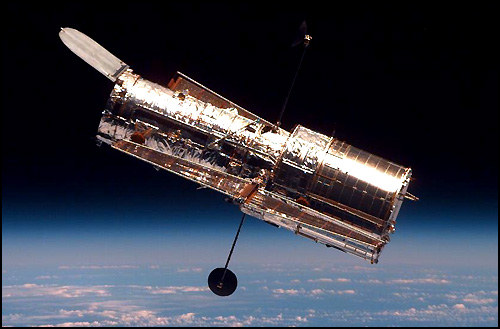
Watch a live, six-hour (or at least parts of it) webcast of STS-125, Monday, May 11, at 12:30 p.m. PDT at spaceflightnow.org, hosted by Robert Crippen, former space shuttle astronaut, who will give viewers truly unprecedented access and a virtual presence of nearly every aspect of a shuttle launch and spacewalk.
The mission is to further improve the Hubble Space Telescope, and refit it to survive another four to five years. The web event is unique for a couple of reasons. First, Crippen, who has performed many extra-vehicular activities (EVAs), or spacewalks, will give special insight into this, the last shuttle mission scheduled to work on the space telescope. Second, the show will offer full-length, live coverage of the entire operation, which involves hundreds of people on the ground, during an uninterrupted continuum, with no edits or censoring for national security reasons. Presumably, NASA will have hidden away all the really cool stuff that nobody else has. (LOL).
What's so important about Hubble, anyway?
The big answer you will usually hear is that Hubble has helped us understand where we come from by looking back in time through space, getting us closer and closer to the Big Bang. However, I honestly think the big thing that people really care about is closer than that. I think Hubble's big story has been the finding of planets, and with it, finding that it is more likely now than ever before that we may one day meet E.T.
Before the Hubble Space Telescope Launched with it's bad case of astigmatism (a mirror had been ground with an imperfection a fraction of the diameter of a human hair), there was no evidence that planets existed outside our Solar System.
In fact, there were credible astronomers who said it may be likely that our star system was an aberration--unique and alone--in having a system of regularly orbiting planets. Without planets outside our Solar System, forget about life elsewhere.
However, since the advent of Hubble, and the addition of its corrective lens (yes, it's a giant contact lens), astronomers have discovered nearly conclusive evidence of thousands of planets around hundreds of stars in our galaxy, intimating the likelihood of billions of similar results possible throughout the universe.
----------
As a refresher, a star system--such as the Solar System (Sol being the name of our star, which we call the sun), is a system of planets or other bodies orbiting a star or group of stars. It turns out that many if not most systems are binary star systems, or systems with two suns at their centers.
But, I digress.
A galaxy is a gigantic conglomeration of billions of stars, planets, and innumerable other bodies, such as the Milky Way Galaxy, in which our planet and Solar Sytem live. The Universe is, of course, everything in the cosmos (cosmos is the everything of everything), in which billions of galaxies and untold trillions of stars reside. I know; it makes me fell dinky too.

No comments:
Post a Comment